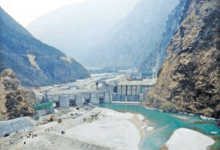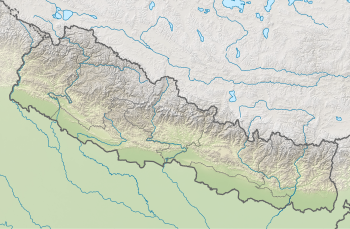Upper Tamakoshi Hydroelectric Project
The Upper Tamakoshi Hydroelectric Project is a 456 MW peaking run-of-the-river hydroelectric project in Nepal.[1] It is the largest hydroelectric project in Nepal, and is expected to be completed in 2020.[2] It is sited on the Tamakoshi River (also spelled Tamba Koshi), a tributary of the Sun Kosi river (also spelled Sunkoshi), near the Nepal–Tibet border.
| Upper Tamakoshi Hydroelectric Project | |
|---|---|
 Upper Tamakoshi diversion dam | |
 Location of Upper Tamakoshi Hydroelectric Project in Nepal | |
| Country | Nepal |
| Location | Gaurishankar Conservation Area, Dolakha District |
| Coordinates | 27.844°N 86.218°E |
| Purpose | Hydroelectricity |
| Status | Under construction |
| Construction began | 2011 |
| Opening date | 2020 (est.) |
| Owner(s) | Upper Tamakoshi Hydropower Limited |
| Dam and spillways | |
| Type of dam | Run-of-river |
| Impounds | Tamakoshi River |
| Height | 22 m |
| Length | 60 m |
| Coordinates | 27.925°N 86.213°E |
| Type | Underground 142 m long hall |
| Hydraulic head | 822 m |
| Turbines | 6×Pelton wheels |
| Installed capacity | 456 MW @ maximum flow 66 m3/s |
| Annual generation | 2,281 GWh |
| Website tamakoshihydro | |
The Upper Tamakoshi Hydroelectric Project is a Nepal national priority project. When it is completed, it is projected be the largest hydroelectric plant in Nepal, with a power output equivalent to two-thirds of Nepal's current power generation.[3][4] The Project is entirely financed from domestic financial institutions and companies.
Financing and organization
Nepal Electricity Authority (NEA) has established an autonomous company named Upper Tamakoshi Hydropower Limited (UTKHPL) in March 2007 (2063/11/25 B.S.) as an executing agency for the implementation of the Project. There are six full-time and two invitee members in the Board of Directors (BoD) at present. Out of six full-time members, four members from NEA, one from Employees Provident Fund (EPF) and one from Nepal Telecom (NTC) are representing in the BoD. Similarly, representatives of Citizen Investment Trust (CIT) and Rastriya Beema Sansthan (RBS) are also in the BoD as invitee members.[5]
The majority share (51%) of the Company is held by four public entities, namely, Nepal Electricity Authority (NEA), Nepal Telecom (NTC), Citizen Investment Trust (CIT) and Rastriya Beema Sansthan (RBS). NEA has 41% stake, NTC has 6% and CIT & RBS each has 2% stake in the Company. Similarly, general public and residents of Dolakha District will have 15% and 10% share respectively. The remaining 24% share will be taken over by contributors in Employees Provident Fund (EPF), NEA & Companys staffs and staffs of financial institutions providing loans.[5]
Construction

Construction began in February 2011, and the project was originally slated for completion in July 2018, later pushed back to December 2018, and again pushed back to November 2019.[3][6][7] Works suffered new delays in 2019, and the most recently announced completion date of February 2020 is likely to be missed too.[2] Sinohydro is managing construction.[8]
The Nepalese Army was mobilized to provide security to the site in 2012, after it was reportedly threatened by vandalism and threats to construction staff and foreign workers.[9] Work was disrupted by the April 2015 Nepal earthquake, after which over 200 Chinese workers were evacuated.[3][10] Work was disrupted throughout the construction project by labor strikes.[11][12] The earthquake also caused damage to roads and bridges and buried the troop barracks at the site.[13]
In May, 2018, it was reported that the planned July completion date could be jeopardized by late assembly of the turbomachinery that had been delivered to the site.[14] Later in May, the country's finance minister said that the project was expected to contribute to robust national economic growth in 2018.[15]
Installation of penstocks began in February 2019 by a European contractor after the original Indian contractor failed to perform the work.[16] A new date of November 2019 was set for initial energy production.[7]
Infrastructure
Infrastructure for the plant includes a 142 m long, 25 m high underground powerhouse hall near Gongar Khola, with six Pelton wheels; a 22 m high × 60 m wide dam at Lamabagar; a 360 m high surge shaft; and a total of 16 km of headrace and tailrace tunnels.[3][4] The gross head will be 822 m.[3] Near the dam are two 246 m × 26 m settling basins to remove particles greater than 0.15 mm.[17]
In January 2019 it was reported that the project did not have approval to clear forest land for new double 220 kVA electrical transmission lines to replace existing 132 kVA lines.[18]
References
- "Salient Features". utkhpl.org.np. Retrieved 2017-02-27.
- "Upper Tamakoshi project makes progress on penstock installation". The Kathmandu Post. 11 October 2019.
- Gregory B. Poindexter (May 11, 2015), "Nepal's 456-MW Upper Tamakoshi hydroelectric project suffers "settlement"", Hydro World
- "Upper Tamakoshi Hydropower Project:Half of Tunnel Work Completed", The Kathmandu Post, February 24, 2013, archived from the original on April 18, 2016 – via HighBeam (subscription required)
- "About Tamakoshi Hydro". utkhpl.org.np. Retrieved 2017-02-27.
- Subedi, Bibek (December 22, 2016). "Upper Tamakoshi project: Completion deadline pushed back again". The Kathmandu Post. Retrieved 2019-03-17.
- Penstock pipe-laying work commences at Upper Tamakoshi hydel project, Himalayan News Service, February 25, 2019 – via The Himalayan Times
- H.E. Ambassador Yang houlan visits Upper Tamakoshi Hydroelectric Project being constructed by Sinohydro, States News Service, March 8, 2012, archived from the original on April 9, 2016 – via HighBeam (subscription required)
- "Govt Mobilises APF Team at Upper Tamakoshi Project", The Kathmandu Post, December 16, 2012, archived from the original on April 16, 2016 – via HighBeam (subscription required)
- Nearly 200 Chinese workers stranded but safe in hydropower project construction site in quake-hit Nepal, Xinhua News Agency, 2015-05-03
- Michael Harris (March 24, 2015), "NEA forms committee to mediate worker strike at 456-MW Upper Tamakoshi hydropower plant", Hydro World
- "Works Resume at Upper Tamakoshi", The Kathmandu Post, March 31, 2015, archived from the original on October 18, 2016
- "Upper Tamakoshi Project in crisis as staff, contractor do not return", República, July 19, 2015
- New consultant to be hired for Upper Tamakoshi, Khatmandu: Online Khabar, May 10, 2018
- "Khatiwada Dispels Doubts on 8pc Growth", The Kathmandu Post, May 31, 2018, archived from the original on June 12, 2018 – via HighBeam (subscription required)
- Subedi, Bibek (2018-12-25). "Penstock installation task reassigned to Austrian company". The Kathmandu Post. Retrieved 2019-03-17.
- Ghimire 2012, p. 137.
- Poudel, Umesh (January 30, 2019). "Electricity generated by Upper Tamakoshi hydro project could go to waste". The Himalayan Times.
Sources
- Ghimire, Subash (February 2012), "Land use planning in hydropower development – a case study of upper Tamakoshi Hydroelectric Project" (PDF), Kathmandu University Journal Of Science, Engineering And Technology, 8 (1): 134–141
Further reading
- Bishnudhan Niwas, Annapurna Marg Gyaneswor (February 2011), Project overview (PDF), Upper Tamakoshi Hydropower LimitedCS1 maint: uses authors parameter (link)
External links
- Official website
